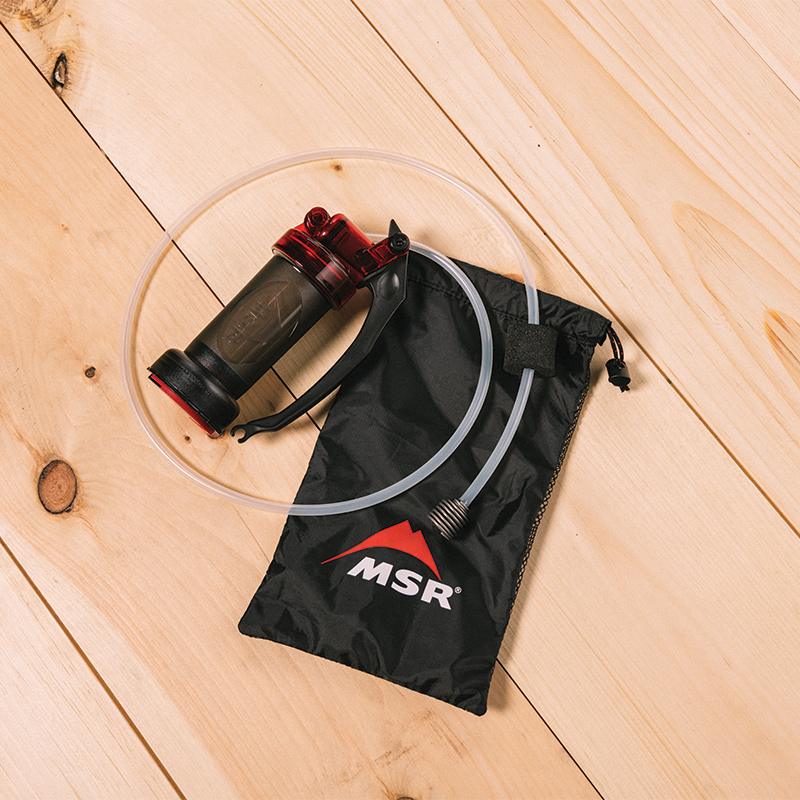Treatment #1: Filters
Water filters work by forcing water through a filtration element with tiny pores. The element physically removes bacteria and protozoan cysts, allowing clean water to flow through. Most filters don’t remove viruses because they’re much smaller than other pathogens (a few do have the ability to deal with them using additional purification measures). Many require you to periodically replace the element, and silty water can clog them. Filters come in a variety of shapes and sizes, from single-serving bottles to group-size pouches.
Pump Filters
These devices include a hose that goes into the water source, a hand pump to force water through the element, and an outflow that adds clean water to your bottle or reservoir.
Pros: Can treat large volumes of water relatively quickly; can pull from shallow or small water sources
Cons: On the heavy/bulky side; can break in the field; require manual pumping
Best For: Backpacking; groups
Gravity Filters
Fill this filter’s large, flexible water pouch and hang it up, then watch as gravity forces the water through the element for you.
Pros: Simple; require little effort; can treat large volumes of water
Cons: Work slowly; can be hard to fill from shallow water sources
Best For: Backpacking; groups
Bottle and Squeeze Filters
To use this personal-size filter style, fill the bottle or reservoir with water, then force it through the element by squeezing, sipping through an integrated straw, or pressing it coffee-style.
Pros: Small; lightweight; simple; work quickly; more affordable
Cons: Don’t treat large volumes efficiently
Best For: Day hikes; trail running; backpacking in areas with plentiful water; ultralighters
Straw Filters
These ultralight, simple filters let you sip water directly from the water source.
Pros: Very small; very lightweight; more affordable
Cons: Don’t treat large volumes efficiently; require you to get down on your stomach to drink
Best For: Day hiking; trail running; ultralighters; emergency use
PLUS: Purifying filters
A few specialized filters do neutralize viruses as well as bacteria and protozoa, either through the addition of chemicals or a high-tech ion exchange process. They work well anywhere in the world, but some are expensive.
Treatment #2: Ultraviolet Light
These devices work by zapping water with UV light, thereby damaging any pathogens’ DNA and rendering them unable to infect you. They work best in clear water because germs can “hide” behind tiny particles in cloudy or silty water. UV devices work on bacteria, protozoa, and viruses.
Pros: Quick; simple; lightweight; some are rechargeable
Cons: Don’t treat large volumes of water efficiently; more expensive
Best For: Day hiking; backpacking; international use
Treatment #3: Chemicals
Certain chemicals kill all pathogens, including viruses. Just add the drops or tablets to your bottle or reservoir and wait for the chemicals to work their magic (usually 30 minutes to 4 hours for certain pathogens). The most common chemical treatment is chlorine dioxide. Iodine is an old-school solution that also works, but has its cons: It tastes weird, doesn’t work on crypto, and isn’t safe for pregnant women or those with thyroid conditions.
Pros: Very small; very lightweight; very affordable
Cons: Take a long time; can add an unpleasant taste
Best For: Backpacking; ultralighters; emergency use
What About Boiling?
It’s true: Boiling backcountry water will also take care of all pathogens. But you’ll have to pack enough extra fuel to handle all your drinking water needs, and this method also requires you to wait for water to cool before drinking. Water treatment methods are quicker and more convenient. One circumstance where boiling does work well: cooking. No need to pretreat the water you’ll use to cook your rice or pasta—just bring it to a rolling boil first.




